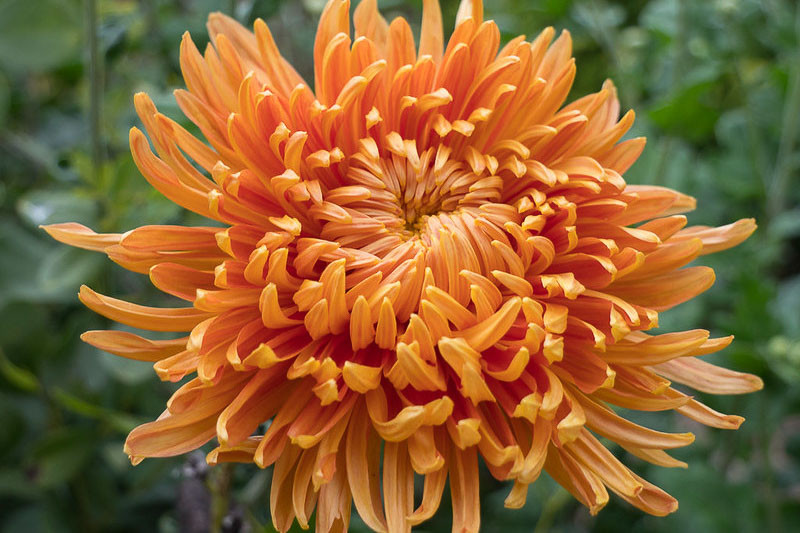With their bold, bright blooms, chrysanthemums are a staple in fall gardens and flower arrangements. But did you know there are many other flowers that closely resemble the familiar “mum”? From daisies to asters, let’s explore 12 beauties that could easily be mistaken for chrysanthemums.
Shasta Daisy
The classic perennial Shasta daisy (Leucanthemum x superbum) looks almost identical to the Decorative class of chrysanthemum It has a large flower with white petals surrounding a yellow center, blooming throughout summer. Shastas grow 2-3 feet tall in full sun and average soil They make excellent cut flowers.
Oxeye Daisy
Also called marguerite oxeye daisy (Leucanthemum vulgare) is a European native naturalized in North America. It looks like a miniature Shasta with white petals and yellow disk florets. Oxeye daisies reach 1-3 feet tall and thrive in full sun. They spread readily by seed and rhizomes.
Coreopsis
Cheery coreopsis (Coreopsis grandiflora) produces loads of bright yellow blooms resembling small chrysanthemums. This perennial reaches 1-2 feet tall and tolerates heat, drought, and poor soil but thrives in average conditions. It’s excellent for borders, containers or cut flowers.
Black-Eyed Susan
A classic autumn wildflower, black-eyed Susan (Rudbeckia hirta) looks like a shaggy, informal version of the decorative mum. Its yellow petals surround an eye-catching chocolate-brown center. Black-eyed Susans grow 1-3 feet tall in prairies, meadows and open woodlands.
Dahlia
Though not related, the summer-blooming dahlia has flower forms that closely mimic fancy chrysanthemum types like Pompoms and Decoratives. With good soil and ample water, dahlias produce abundant, long-lasting blooms in almost every color. Protect tubers over winter in zones colder than 8.
Zinnia
Available in almost every color but blue, zinnias resemble informal, single-flowered chrysanthemums. Their daisy-like blooms with visible central disks attract butterflies all summer long. Compact varieties make excellent container plants. Zinnias thrive in hot, sunny spots with average to fertile soil.
Aster
This diverse perennial genus contains many species that resemble wild chrysanthemums. Asters bear clusters of daisy-like flowers in late summer and fall. They range from small, groundcover types to tall meadow plants. Asters prefer full sun to part shade and average to moist soil. Excellent nectar sources for pollinators.
African Daisy
With sunny daisy blooms on short stems, African daisies (Arctotis, Dimorphotheca, Osteospermum spp.) look like petite, heat-loving chrysanthemums. These South African natives are technically tender perennials grown as annuals. African daisies need fast-draining soil and at least 6 hours of direct sun.
Helenium
Also called sneezeweed, Helenium produces masses of bright daisy-like blooms that resemble single or semi-double chrysanthemums. Flower colors include yellow, burnt-orange, mahogany-red and combinations. Heleniums grow 3-4 feet tall in full sun and evenly moist soil. Great for borders and cut flowers.
Gerbera Daisy
The brightly colored Gerbera daisy (Gerbera jamesonii) is often compared to the Anemone type of chrysanthemum. Its large, showy blooms feature multiple layers of pointed petals in vibrant hues. Gerbera daisies need plenty of light and good drainage. Grow as annuals or bring indoors over winter.
Daisy Fleabane
A classic wildflower found in fields and meadows, daisy fleabane (Erigeron spp.) produces a profusion of small, white daisy blooms that closely resemble Pompom and Single chrysanthemums. Fleabanes grow 1-3 feet tall in full sun and average soil. They make carefree, drought-tolerant additions to gardens and wildflower mixes.
Gaillardia
Also called blanketflower, Gaillardia offers big, daisy-like blooms similar to single chrysanthemums but in hot colors like red, orange and yellow. Flowers have fringed petal tips. Heat and drought tolerant, these short-lived perennials reach 1-2 feet tall. Stellar for borders, rock gardens and containers.
With their diversity of form and color, these chrysanthemum look-alikes will give your garden season-long color. Use different varieties together for a lively fall display. Your neighbors will have to look twice to spot the imposters mixed in among the real mums!
Chrysanthemum Varieties A to Z
FAQ
What flowers are similar to chrysanthemums?
What looks like chrysanthemum?
What flowers are in the chrysanthemum family?
Is a chrysanthemum a cut flower?
Bloom color: yellow, orange, red and magenta, monochrome or variegated. Bloom time: fall. Bloom size: large (about 6 inches across, or 15 cm). Size: 3 feet tall and in spread (90 cm). Suitable as cut flower: absolutely yes! 10. ‘Chesapeake’ Spider Mum Chesapeake spider mum must be one of the most elegant chrysanthemums on the market.
What is a decorative Bloom Chrysanthemum?
Decorative Bloom chrysanthemums are flowers with small and short blooms, with luscious petals that curve towards the center. This flower’s color palette is rich, filled with bronze and amber shades. The petals are usually subtle orange color toward the tips but turn a darker red and brown in the very center.
What do chrysanthemum flowers look like?
Flowers are a salmon-pink color and may vary slightly in hue, from slightly more orange to slightly more pink. This chrysanthemum variety produces gorgeous large white flowers with very rounded petals. The Ja Dank Chrysanthemum has large, showy, white flowers. The “intermediate incurve” blooms are very rounded with petals that curve gently upwards.
What does a cushion Chrysanthemum look like?
The Cushion chrysanthemums grow to be relatively low and short, unlike other types of mums. These flowers grow close to the ground but produce wide and bushy flowers. Their name comes from the thickness of the foliage and the cushion-like flower petals. These flowers come in various colors, from creamy-white and yellow, to intense purple and red.
- A Complete Guide to Caring for Yuki Cherry Blossom Shrub - January 23, 2025
- Identifying Red Hot Poker Seeds: What to Look For When Harvesting Torch Lily Pods - January 23, 2025
- A Complete Guide to Harvesting Evening Primrose Seeds - January 23, 2025

